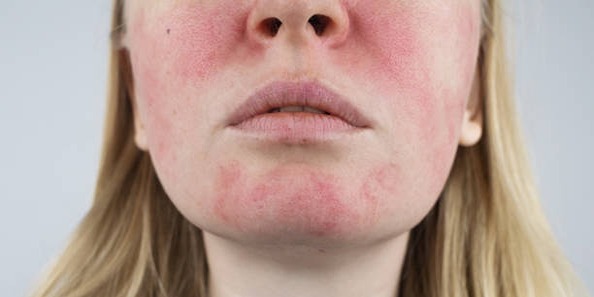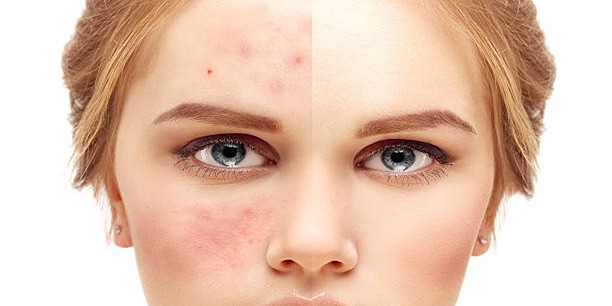Rosacea and red patches on the skin can be more than just cosmetic concerns; they often carry emotional and psychological weight for those affected. These common skin issues can signal sensitive skin or an underlying condition that requires both understanding and special care. In this guide, we aim to equip you with knowledge and strategies to confidently manage and mitigate these skin ailments. We'll delve into understanding the triggers, exploring effective skincare routines, and uncovering the role of diet and lifestyle in maintaining a healthy complexion. Our goal is not only to alleviate the symptoms but also to empower you with a sense of control over your skincare journey. Join us as we embark on a path to soothe your skin and restore its natural balance.
What is Rosacea?

Rosacea is a chronic skin condition that primarily affects the face, causing redness and visible blood vessels. It commonly appears on the forehead, cheeks, chin, and nose but can also affect the neck, chest, and ears in some cases. This condition typically starts with flushing or blushing episodes that may come and go before progressing to persistent redness over time. Other symptoms may include small, red bumps or pimples, eye irritation, and thickened skin on the nose called rhinophyma.
The psychological impact of dealing with visible skin conditions
The physical symptoms of rosacea and red patches can be challenging enough, but the emotional and psychological effects can often be just as trying. Many individuals with these skin concerns may experience low self-esteem, anxiety, depression, or social withdrawal due to feeling self-conscious about their appearance. This burden can significantly impact one's quality of life, making it a crucial aspect to address in managing these skin conditions.
Daily Skincare Routine for Sensitive Skin
Managing rosacea and red patches requires a tailored approach to skincare. Those with these skin concerns should prioritize gentle, non-irritating products and avoid harsh chemicals or fragrances that can trigger flare-ups. Here's a general daily skincare routine for sensitive skin:
- Cleanser: Use a mild, non-foaming cleanser specifically designed for sensitive skin. Avoid scrubbing or using hot water to prevent further irritation.
- Toner: Look for a gentle, suitable toner that helps balance the skin's pH and removes any leftover impurities after cleansing.
- Moisturizer: Choose a fragrance-free, lightweight moisturizer that provides hydration without clogging pores.
- Sunscreen: Always use a broad-spectrum sunscreen with at least SPF 30 to protect sensitive skin from UV rays.
- Makeup: Opt for hypoallergenic, non-comedogenic makeup products that won't irritate the skin or clog pores.
- Nighttime Routine: Before bed, gently cleanse your face and apply a gentle moisturizer. Consider using a product with ingredients like ceramides, hyaluronic acid, or niacinamide to help repair and strengthen the skin barrier.
Common Triggers for Rosacea and Red Patches
Identifying triggers is key in controlling rosacea and red patches. While triggers can vary from person to person, some common ones include:
- Hot liquids: Consuming hot beverages such as coffee, tea, or hot cocoa can trigger flushing and redness.
- Spicy foods: Spicy foods can cause blood vessels to dilate and lead to redness and irritation.
- Sun exposure: UV rays are a common trigger for rosacea flares. Always wear sunscreen and try to limit sun exposure.
- Stress: Emotional stress can cause a surge in hormones that lead to flushing and inflammation.
- Alcohol: Alcohol consumption can dilate blood vessels and trigger flushing, especially when consumed in excess.
Professional Treatments and Skincare Products
While there is no cure for rosacea, several treatments and skincare products can help manage symptoms. It's crucial to consult a dermatologist to determine the best course of action for your specific condition. Some professional treatments may include:
- Prescription Topicals: Topical creams or gels containing antibiotics, retinoids, or azelaic acid can help reduce inflammation and control redness.
- Oral Medications: In some cases, oral antibiotics or antihistamines may be prescribed to help manage symptoms.
- Laser Therapy: This treatment uses pulses of light to reduce visible blood vessels and redness in the skin.
- Dietary Supplements: Some supplements such as Omega-3s, probiotics, and zinc may help improve skin health and manage symptoms.
- Prescription Skincare Products: Your dermatologist may recommend specific skincare products tailored to your skin's needs, such as gentle cleansers, moisturizers, or topical treatments.
Lifestyle Factors to Consider
While skincare plays a significant role in managing rosacea and red patches, certain lifestyle factors can also impact symptoms. Here are some tips to help maintain healthy skin:
- Stay hydrated: Drink plenty of water to keep your skin hydrated and flush out toxins.
- Reduce stress: Find ways to manage stress, such as exercise, meditation, or therapy.
- Avoid harsh weather conditions: Extreme temperatures, wind, and humidity can trigger redness and irritation. Protect your skin with appropriate clothing or seek shelter if necessary.
- Use caution with exercise: Vigorous activities that raise body temperature may worsen symptoms. Consider low-impact exercises like walking or yoga instead.
Makeup Tips and Tricks

While makeup can't cure rosacea or red patches, it can help conceal visible symptoms and boost self-confidence. Here are some tips for applying makeup on sensitive skin:
- Use a color-correcting primer: A green-tinted primer can help neutralize redness before applying foundation.
- Choose light coverage foundations: Heavy, full-coverage foundations can exacerbate redness and irritation. Opt for light, buildable coverage foundations instead.
- Avoid powder products: Powder products can clog pores and accentuate dry patches. Stick to cream or liquid formulas.
- Be gentle when applying makeup: Use a soft brush or sponge to gently apply makeup instead of rubbing it onto the skin.
- Remove makeup carefully: Avoid harsh scrubbing or rubbing when removing makeup. Use a gentle cleanser and follow up with moisturizer to soothe the skin.
Skincare for sensitive skin requires patience, consistency, and gentle care. With the right skincare routine, lifestyle adjustments, and professional treatments, individuals can manage rosacea and red patches effectively and improve their overall quality of life.
Conclusion
While rosacea and red patches can be frustrating to manage, it's essential to remember that everyone's skin is unique. What works for one person may not work for another, so it's crucial to consult a dermatologist and tailor a skincare routine that addresses your specific concerns. By identifying triggers, using gentle products, incorporating lifestyle changes, and seeking professional help when needed, individuals can control symptoms and maintain healthy, glowing skin. Remember to be patient with yourself and your skin, as managing sensitive skin is a continuous process that requires dedication and self-care.




